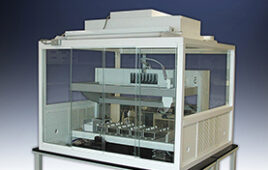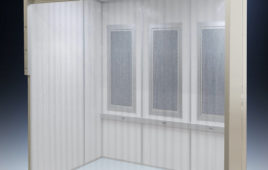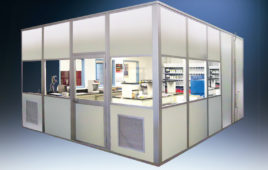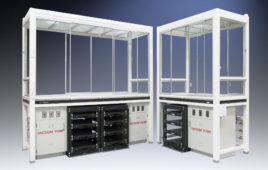A glovebox is a sealed enclosure that allows handling of materials through long, relatively impermeable gloves secured to ports in the walls of the enclosure. The purpose of a glovebox is protection or isolation, which is provided by the physical barrier. Depending on the type of glovebox, the physical barrier may be to isolate a sensitive material inside the box from environmental contamination (controlled atmosphere type) or to protect the operator from hazardous materials being manipulated inside the box (ventilated type). Most gloveboxes have a main chamber where manipulations occur and a smaller transfer or antechamber where samples, small apparatus, and supplies are introduced into the main chamber.
To provide a physical barrier, all well-constructed gloveboxes should be quality control checked for leak tightness. The manufacturer may check for leaks prior to shipment using a helium mass spectrometer. A test probe checks for the presence of leaks at all joints, seals, and seams (Photo 1).

TYPES OF GLOVEBOXES
Controlled atmosphere gloveboxes, sometimes called dry boxes, create oxygen-free and/or moisture-free conditions inside the box so that atmosphere-sensitive materials may be manipulated. These boxes have applications in organometallic chemistry, hydrophilic chemical handling, organic synthesis, electronic component assembly, lithium battery handling, and hemoglobin or metabolic research.
To create an oxygen/moisture-free atmosphere, the ambient environment inside the box is replaced with an inert gas such as nitrogen, argon, or helium. The boxes have inlet and outlet valves that service the transfer and main chamber. Inlet valves fill the box with inert gas. Outlet valves connect to a rotary vane vacuum pump to evacuate oxygen and moisture from the box. To achieve moisture and oxygen levels of 1% or below requires multiple evacuation and fill cycles, as many as 200 or more depending on the size of the glovebox, which can be a time-consuming and labor-intensive process if done manually. Some gloveboxes offer an automated means of filling and evacuating that allows for unattended operation. To further reduce oxygen and moisture levels, controlled atmosphere gloveboxes may utilize a drying train, which functions by circulating the glovebox atmosphere through a copper catalyst and/or molecular sieve. More sophisticated drying trains/gas purifiers also include a means to automatically regenerate the media (Photo 2).
When selecting a controlled atmosphere glovebox, the focus should be on its ability to maintain an inert atmosphere. Leak tightness should be the primary consideration. Ask the glovebox manufacturer for its published leak rate. ISO (the International Organization for Standardization) 10648-21 classifies containment enclosures based on their leak tightness and provides methods for checking a glovebox’s leak rate. ISO 10648-2 recognizes four Classes of containment enclosures, 1 through 4, with Class 1 having the lowest hourly leak rate, which is characteristic of controlled atmosphere gloveboxes under inert gas conditions. For Class 1 containment enclosures, the oxygen leak decay test method is specified. This test consists of purging the enclosure with an inert gas so that its oxygen level is at its lowest level and then measuring the increase in the oxygen concentration over a period of time. During the test, the glovebox is maintained at a negative pressure using a pressure-regulating device. Two pressure levels are evaluated: one that represents usable permeation under normal operation and the other, known as acceptance level, which submits the box to four times the normal pressure (worst case scenario). For example, the oxygen leak rate on a Protector Stainless Steel Controlled Atmosphere Glovebox is <1.67 ppm/minute when tested at -1000 Pa and 0.14 ppm/minute when tested at -250 Pa.
The permeability of the liner material to oxygen and moisture affects the glovebox’s leak rate. Porosity and thickness of the material contribute to its permeability. For example, less oxygen and moisture will permeate through a stainless steel liner than a fiberglass liner that is more than twice as thick. For example, a controlled atmosphere glovebox with a 12 gauge (0.105″) Type 304 stainless liner has a usable oxygen permeation rate of 0.14 ppm/minute at -250 Pa, while its 0.25″ thick fiberglass-lined counterpart has a slightly higher usable permeation rate of 0.16 ppm/minute at ±250 Pa. Both boxes meet the ISO 10648-2 specification.

Ventilated gloveboxes, also called filtered gloveboxes, have inlet and outlet particulate filters (either High Efficiency Particulate Air Filters or Ultra Low Particulate Air Filters) and a blower to circulate the air. The exhaust air is either returned to the laboratory or may be thimble ducted to the outside. The filtered air and physical barrier of the glovebox provide protection to the user when manipulating hazardous particulates or powders. Applications for this type of glovebox include pharmaceutical R&D, biochemistry, non-biohazardous microorganisms, particulate chemical carcinogens, asbestos handling, proteins and enzyme work, and nanoparticle manipulation. In addition, by reversing the negative air pressure in the main chamber to positive pressure, these boxes may be used for cleanroom applications.
When selecting a ventilated glovebox, key specifications to consider include particulate cleanliness, particulate containment, and balance stability. The glovebox application deter mines the specification parameters required. ISO Standard 14644-12 designates airborne particulate cleanliness inside a clean air glovebox by Class definitions. ISO Class 3 is equivalent to 35 particles 0.5 μm or larger per cubic meter of air (Figure 1). ISO Class 3 cleanliness is equivalent to Class 1 air conditions as defined by Federal Standard 209E,3 which is one particle, 0.5 μm or larger per cubic foot of air per minute.
To verify containment, some glovebox manufactures test for particulate contamination outside the glovebox. Particulate containment can be tested by having operators with varied levels of work practice perform repeated operations involving a non-toxic powder inside the glovebox and then measuring the presence of that powder in the operators’ breathing zones, filter exhaust, transfer chamber, and room. Low or no particulates detected in those areas confirm the containment of the glovebox. Third party verification of containment adds credibility to the test results. For example, SafeBridge Consultants, Incorporated confirmed the results of naproxen sodium containment testing conducted on filtered gloveboxes. Samples on filter cassettes were analyzed using high performance liquid chromatography coupled with fluorescence detection capable of detecting as little as two nanograms. Particulates detected were less 20 nanograms per cubic meter indicating excellent containment.
Weighing potent powders is a common application for ventilated gloveboxes. Since analytical balances can be sensitive to motion disturbances, vibration from the glovebox’s blower may cause reading errors. Some glovebox manufacturers test their boxes for stability and indicate displacement at various blower speeds.
A Class 3 biological safety cabinet, as designated by the Centers for Disease Control,4 is a special type of ventilated glovebox that is designed for work with Biosafety Level 4 pathogenic agents, providing maximum protection. The Class 3 cabinet is defined as a totally enclosed, ventilated cabinet of leak-tight construction. Operations in the cabinet are conducted through attached rubber gloves. The cabinet is maintained under negative air pressure of at least 0.5-inch (12.7 mm) water gauge. Supply air is drawn into the cabinet through HEPA filters. The exhaust air is treated by double HEPA filtration, or by HEPA filtration and incineration. The cabinet also has a transfer chamber capable of sterilizing work materials before exiting the glovebox containment system. In general, these cabinets are custom-built to fit into a specific area of the laboratory and for a specific use.
Combination gloveboxes, as the name implies, have the capability to function as either a ventilated glovebox or a controlled atmosphere glovebox. They cannot function as both at the same time but are easily and quickly convertible. They are useful in laboratories with several researchers sharing a glovebox or in laboratories that anticipate that their applications may change in the future.

(Click Image For A Larger Version)
CONCLUSION
Gloveboxes provide a physical barrier and, depending on their type, either protect the materials inside from outside contamination or protect the user from hazardous materials inside. The level of containment they provide depends on the performance of the glovebox, specifically its leak rate. Determining the right glovebox and level of containment requires evaluation and consultation with a safety officer.
References
- ISO 10648-2:1994. Geneva: ANSI, 1994. Print.
- ISO 14644-1:1999. Geneva: ANSI/IEST/ISO, 1999. Print.
- U.S. General Services Administration. Federal Standard 209E. Mount Prospect: 1992. Print.
- Chosewood, L. Casey, MD, and Deborah E., DrPH, CBSP Wilson. U.S. Government. CDC-NIH Biosafety in Microbiology and Biomedical Laboratories. Washington: U.S. Government Printing Office, 2009. Print.
Gary Roepke is Project Engineer and Bob Applequist is Product Manager for Labconco Corporation, a U.S. manufacturer of gloveboxes, biological safety cabinets, fume hoods, and other ventilation equipment for the laboratory.




